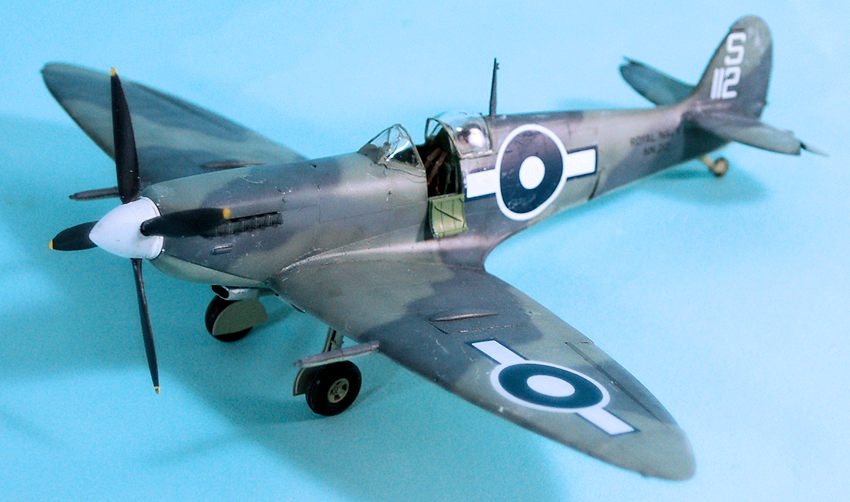
Special Hobby 1/48 Seafire III
| KIT #: | 48128 |
| PRICE: | $39.95 SRP |
| DECALS: | Three options |
| REVIEWER: | Tom Cleaver |
| NOTES: | Aeromaster 48-442 “Supermarine Seafires Pt.II” |

| HISTORY |
The Last Day of World War II:
The first quarter moon hung in the western sky gleaming dimly through scattered clouds over the Pacific; the moonlight was sufficient to illuminate the many wakes of the huge formation of ships below. At 0300 hours, an observer would have heard the calls to reveille echoing across the still-dark sea throughout the darkened fleet.
It was Wednesday, 15 August 1945, just another of many long tiring days faced by the men of the United States Third Fleet. In recent days, rumors had raced through the destroyers, cruisers, battleships and aircraft carriers of the mightiest fleet the world had ever seen that the war could end at any time. Those who passed on the rumors were quickly reminded by their salty seniors of the old navy saying, “Believe nothing that you hear, and only half of what you see.”
The British Pacific
Fleet, assigned as Task Force 37, had joined Task Force 38 on 16 July,
augmenting the force with fo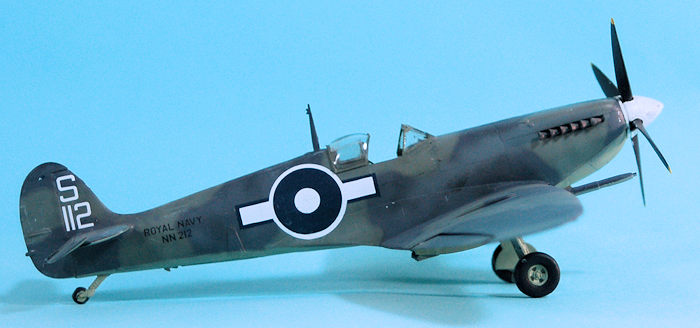 ur fleet carriers carrying 200 additional aircraft: Supermarine Seafire IIIs, Fairey Firefly Is, Grumman Avengers and Hellcats, and
Vought Corsairs. Unfortunately, three of the British carriers had been forced to
retire three days before to the advanced British base at Manus atoll in
Admiralty Islands south of the Philippines, known to the sailors of the Royal
Navy as “Scapa Flow with bloody palm trees,” due to lack of British tankers for
replenishment. The carrier HMS
Indefatigable,
with her escort, the battleship HMS
King George V,
cruisers HMS
Newfoundland,
and
Gambia,
and destroyers HMS
Barfleur, Wakeful,
Wrangler, Teazer, Termagant
and
Tenacious,
and HMAS
Napier
and
Nizam,
remained with the Americans as Task Group 38.5. The Seafires of 24 Naval Fighter
Wing, operated by 887 and 894 Squadrons, had the best low altitude performance
of any fighter in the fleet and were the first line of defense against the
Japanese tactic of low altitude kamikaze attacks.
ur fleet carriers carrying 200 additional aircraft: Supermarine Seafire IIIs, Fairey Firefly Is, Grumman Avengers and Hellcats, and
Vought Corsairs. Unfortunately, three of the British carriers had been forced to
retire three days before to the advanced British base at Manus atoll in
Admiralty Islands south of the Philippines, known to the sailors of the Royal
Navy as “Scapa Flow with bloody palm trees,” due to lack of British tankers for
replenishment. The carrier HMS
Indefatigable,
with her escort, the battleship HMS
King George V,
cruisers HMS
Newfoundland,
and
Gambia,
and destroyers HMS
Barfleur, Wakeful,
Wrangler, Teazer, Termagant
and
Tenacious,
and HMAS
Napier
and
Nizam,
remained with the Americans as Task Group 38.5. The Seafires of 24 Naval Fighter
Wing, operated by 887 and 894 Squadrons, had the best low altitude performance
of any fighter in the fleet and were the first line of defense against the
Japanese tactic of low altitude kamikaze attacks.
Aboard HMS Indefatigable, the flight deck was abuzz with activity as men worked in the pre-dawn grayness to ready the Seafires for their first offensive operation since returning to the waters off Japan in mid-July. Three Seafire IIIs of 887 and four of 894 Squadrons were assigned to escort six Avengers of 820 Squadron and four Fireflies of 1772 Squadron, for a dawn strike against the kamikazes at Kisarazu airfield, 30 miles south of Tokyo. It was considered likely that this was to be the last air strike by units of the Fleet Air Arm in the Second World War.
Among the pilots who manned the Seafires was Sub Lieutenant Fred Hockley, assigned as flight leader of the four Seafires from 894 Squadron which would fly close escort. Son of a foreman with the Cambridge water board and heavily involved in his local church and competitive swimming before the war, Hockley had joined the Royal Naval Volunteer Reserve when the war broke out and trained as a naval fighter pilot. He was a combat veteran now, having flown the Seafire III in operations over southern France a year ago and against the Japanese since the Palembang strikes in Janaury 1945 that marked the arrival of the British Pacific Fleet. As he slipped into the Seafire’s tight cockpit and adjusted his Sutton harness, Hockley thought to himself how lucky he was to be in command of the last Fleet Air Arm fighter mission of the war - it would be a tale to tell the grandchildren he hoped someday to have.
The three 887 Squadron Seafires that would fly high cover were led by Sub-Lieutenant Victor Lowden. Born in Bangkok where his father worked as an accountant and educated at St. John’s College, Cambridge, Lowden had arrived in the Pacific and joined 887 in May while the Royal Navy was engaged in stopping kamikazes based in the Sakishima Islands from attacking the Allied fleet off Okinawa. Since the fleet’s return from Australia the month before, he had engaged in combat over Shikoku and Honshu and attacks on shipping and shore installations near Sendai.
At about 0530 hours,
Hockley could just see the dark mass of the coast of Honshu ahead through the
thickening clouds. At that moment, the Avenger leader passed the word that they
were aborting the attack on K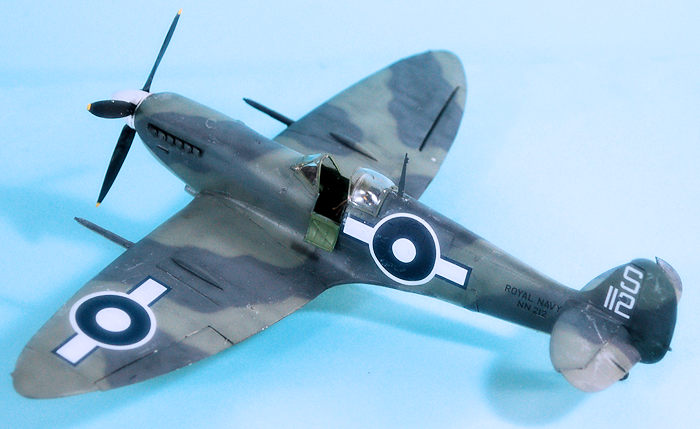 isarazu airfield due to the poor weather and would
attack their secondary target, a chemical weapons factory at Odaki. When Hockley
pressed his radio switch to reply, he discovered when no one responded that his
radio transmitter had malfunctioned; moments later the receiver also died.
Nevertheless, he decided to press on with the mission, relying on hand signals
to his wingman, Ted Garvin.
isarazu airfield due to the poor weather and would
attack their secondary target, a chemical weapons factory at Odaki. When Hockley
pressed his radio switch to reply, he discovered when no one responded that his
radio transmitter had malfunctioned; moments later the receiver also died.
Nevertheless, he decided to press on with the mission, relying on hand signals
to his wingman, Ted Garvin.
On approach to Odaki, the Fireflies and Avengers dropped to 1000 feet over the flat plain and bored in for their rocket and bomb runs. Just at that moment, two Zekes were spotted below the bombers. Sub-Lieutenant Randy Kay, leader of the second 894 pair, called out that they were probably decoys. A moment later, Kay spotted twelve Zekes that appeared out of the clouds, flashing past the three 887 Seafires 3,000 feet above the four 894 fighters.
With his radio out, Fred Hockley didn’t hear Kay’s shouted warning and only realized the formation was under attack when he saw his wingman break sharply to the right. He was a moment too late flinging his Seafire after the others. Suddenly, the fighter was wracked by the heavy hits of 20mm shells from the Zeke he suddenly saw in his rearview mirror, locked on his tail. Holes appeared in his wing and engine cowling, followed by smoke. The Seafire was mortally injured.
Hockley managed to pull away as his attacker turned to face another Seafire. He pulled back his canopy, unfastened his Sutton harness, pushed open the cockpit side flap and baled out. Falling clear of the fight, he opened his parachute. In a matter of moments he hit the ground hard, outside the village of Higashimura. It took a moment for him to catch his breath and disentangle himself from his parachute. When he stood up, he faced a very surprised and very scared Japanese air raid warden. Fred Hockley raised his arms in surrender.
Victor Lowden saw the twelve Zekes flash past as they dove on the four Seafires below. Instinctively, he winged over, followed by his wingmen, Sub Lieutenants Gerry “Spud” Murphy and W.J. “Taffy” Williams. Selecting s target, Lowden pressed the trigger on the spade grip of his control column as he closed to 800 feet behind the enemy fighter. 20mm cannon shells struck the Zeke until, when about 450 feet ahead, it fell away in flames. Clearing his tail before latching onto a second, Lowden closed in and opened fire. After the first burst, his port cannon jammed and the Seafire yawed from the recoil of the starboard gun with each shot. Stomping rudder and ailerons, Lowden shot down the second Zeke with three bursts from 250 yards before turning after a third enemy fighter. Lowden’s wingman, “Taffy” Williams, also shot down a Zeke and now opened fire at Lowden’s third opponent which quickly went down under their combined fire. The two Seafires and the surviving Zekes twisted and turned, firing for only a brief second at one another as an enemy appeared and then disappeared in their sights. Three managed to get on Lowden’s tail and he hauled his Seafire around in a maximum rate turn, firing at each in turn and damaging two before his speed decayed and gave the Zekes the performance edge just as his remaining cannon fired its last shot and he was out of ammo. Lowden quickly nosed over into a maximum-performance dive and outran his pursuers.
The three surviving
894 pilots stuck with the Avengers as the fight developed. Hockley’s wingman Ted
Garvin was hit and had one cannon jam when his drop tank failed to jettison. He
still managed to damage one that fell away out of the fight that he lost sight
of in the clouds. Randy Kay shot down one of two
Zekes
attacking the Avengers with a 60-degree deflection shot, then blew the tail off
the second while his wingman, Sub-Lt. Don Duncan, hit two that retreated damaged
from the fight and then finished off a third
 despite getting a cannon jam.
despite getting a cannon jam.
“Spud” Murphy found himself behind a pair and quickly dispatched one while then getting locked in a turning fight with the remaining fighter. G-force pinned him in his seat as he managed to pull the nose of his Spitfire ahead of the Zeke and put a burst of 20mm into the enemy that struck the engine and cockpit and it plummeted down.
As fast as the fight had happened, it was over. Minutes later, the recall order went out. The Second World War was over and this was the Fleet Air Arm’s final fight.
Later that morning, a unit from the Imperial Japanese Army’s 426th Infantry Regiment arrived in the village of Higashimura to take custody of Fred Hockley. He was taken to the regiment’s nearby headquarters and placed in a jail cell. Hockley was present when the men heard the voice of their Emperor, telling them to “endure the unendurable” and to surrender. A Colonel came to the jail and informed him of the Emperor’s orders. Later that evening, the cell door opened to reveal a group of Japanese officers led by a Major. Hockley was removed from the cell and marched into the nearby woods where he was forced to kneel. On the Major’s order, one of the junior officers beheaded Hockley with his samurai sword. The body was hidden in a shallow grave. A few days later, fearful that his body would be found when Allied occupation troops arrived, those who had committed the murder returned and dug up Hockley’s body, then burned it. It did them no good, as other soldiers who disagreed with the commission of the war crime informed Allied authorities and the Major who gave the order and the junior officer who carried it out were arrested in October 1945. Following a brief trial, they were hanged as war criminals in November
| THE KIT |
Special Hobby
released their Seafire III kit some six years ago, shortly after they released
their Spitfire Vc kit. It is one of two injection molded kits of the Seafire
III, the other being the terrible Airfix mish-mash of new wings and old Spitfire
V kit that marked the end of the bean counters who nearly destroyed the compan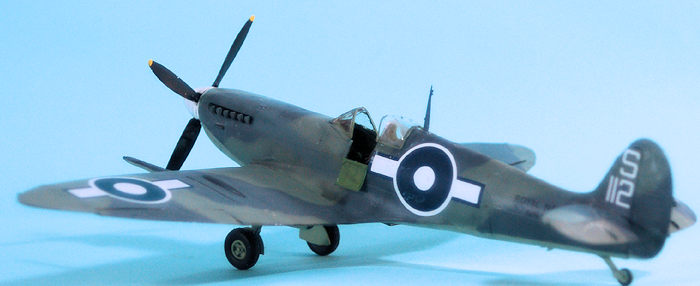 y.
Of the two, the Special Hobby kit is the only one worth building, though the
decals in the Airfix kit would be useful.
y.
Of the two, the Special Hobby kit is the only one worth building, though the
decals in the Airfix kit would be useful.
Special Hobby knew going in they would do multiple releases of the kit in various versions. The one I found on sale at the LHS last year was the “D-Day Fleet Eyes” boxing, which has decals for three Seafire IIIs in D-Day invasion stripes that were flown as naval fire control spotters for the Normandy Invasion. There are other releases out there, including one for the British Pacific Fleet.
The kit is limited-run, and has a cockpit that is acceptable, but not up to the standards of later releases from Airfix and Eduard. Fit is overall acceptable, with the exception that the separate wingtips are not the same thickness as the main wing, which means one either applies a lot of putty and sands it down, or glues on a sheet of .010 sheet plastic and sands it down. This is not a difficult problem to solve. The kit includes a photoetch fret with a two-piece instrument panel, the Sutton harness, and pieces to make up as the catapult attachment points on the fuselage and lower wings.
| CONSTRUCTION |
This is one of the better-fitting Special Hobby kits and it presents only one real problem. Unfortunately, I didn’t discover this problem until it was too late to fix it, but if you follow my advice here when you build yours, you’ll avoid it altogether.\
The upper wing
halves, if they are attached to the lower wing as they are designed to, will be
just a bit narrow at the wing-fuselage join, with the result that the wing will
bend down just enough to lose about a degree of dihedral, which is just enough
to be noticeable - particularly if you sit the completed model next
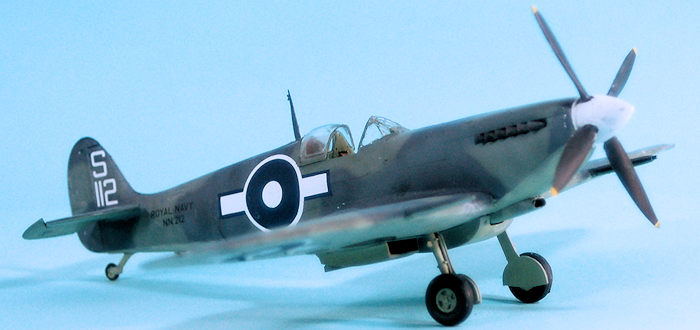 to another
Spitfire model. I didn’t realize this until everything was glued and set up, at
which point it was too late. The solution is to scrape the inner face of the
upper wing part, just a bit, to allow the wing to attach at the correct
dihedral. It won’t take much, just a good scrape at a light angle to take off
enough plastic.
to another
Spitfire model. I didn’t realize this until everything was glued and set up, at
which point it was too late. The solution is to scrape the inner face of the
upper wing part, just a bit, to allow the wing to attach at the correct
dihedral. It won’t take much, just a good scrape at a light angle to take off
enough plastic.
As mentioned, the other problem is that the wingtips are undersized. The airplanes in this release all had clipped wings, so if you do it out of the box, there is no problem. However, if you are going to build a full-span model, you have to deal with the problem. I glued some .010 Evergreen sheet on the lower side, sanded it to shape, then rescribed the single panel line there, and glued the tip to the wing.
The horizontal stabilizers are one piece. I cut off the elevators and glued the horizontal stabilizer in place, then attached an extra Eduard early-style elevator in drooped position.
Filler was needed on all the seams, particularly around the part that has the well for the A-frame arrestor hook.
| COLORS & MARKINGS |
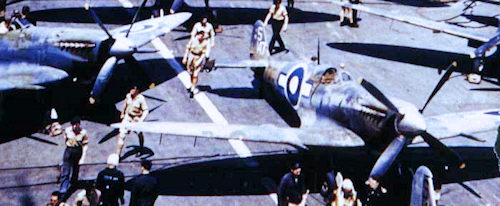 I based my model on
the color photo of Seafire IIIs of 887 and 894 Squadrons aboard HMS
Indomitable
that is included in this review. Most of these airplanes had been aboard since
Indomitable
sailed from Trincomalee in January 1945, and by the end of the war their
camouflage paint was both sun-faded and flattened by salt air.
I based my model on
the color photo of Seafire IIIs of 887 and 894 Squadrons aboard HMS
Indomitable
that is included in this review. Most of these airplanes had been aboard since
Indomitable
sailed from Trincomalee in January 1945, and by the end of the war their
camouflage paint was both sun-faded and flattened by salt air.
I used Tamiya IJA Green for the faded “Sky” undersurface, and Tamiya RLM Grey with a bit of White added for the faded Slate Grey, and a mixture of Tamiya XF-24 Dark Grey and XF-66 Light Grey for the faded Extra-Dark Sea Grey. The camouflage was free-handed, and both upper colors were post-shaded with the addition of more white to “sun-fade” them.
 I used Aeromaster 48-442 “Supermarine Seafires Pt. II”, which has Spud
Murphy’s S-112 of 887 Squadron as one of the options. The sheet is long out of
production but I had no problem obtaining one on eBay at a price not out of line
with contemporary aftermarket decal prices. I did modify it by not using the
wing markings on the sheet, which are way too big according to the photo, but
used a fuselage decal from the Special Hobby Seafire XV decal sheet (since I am
not doing that one in BPF markings) for the wing insignia.
I used Aeromaster 48-442 “Supermarine Seafires Pt. II”, which has Spud
Murphy’s S-112 of 887 Squadron as one of the options. The sheet is long out of
production but I had no problem obtaining one on eBay at a price not out of line
with contemporary aftermarket decal prices. I did modify it by not using the
wing markings on the sheet, which are way too big according to the photo, but
used a fuselage decal from the Special Hobby Seafire XV decal sheet (since I am
not doing that one in BPF markings) for the wing insignia.
The airplanes in the photo do not appear “dinged,” since such dings would have been quickly painted over by the maintenance crews to avoid saltwater corrosion of the aluminum airframe, and I applied a grey exhaust stain on the nose.
| CONCLUSIONS |
If you are a Spitfire “boffin” and want a Seafire III in your collection, this Special Hobby kit is what you want. For anyone with experience assembling limited-run kits, it does not present any insurmountable problems. Mine looks OK even with the “flat” wing, but you know how to solve that problem now.
29 September 2016
Copyright ModelingMadness.com
Review kit and decals courtesy my wallet. “The Last Day of World War II” is adapted from my future book “Tidal Wave.”
If you would like your product reviewed fairly and fairly quickly, please contact the editor or see other details in the Note to Contributors.